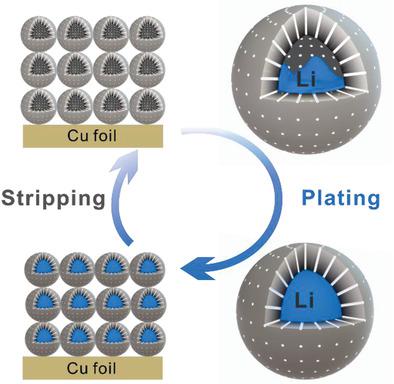当前位置:
X-MOL 学术
›
Adv. Energy Mater.
›
论文详情
Our official English website, www.x-mol.net, welcomes your feedback! (Note: you will need to create a separate account there.)
Stable Nano‐Encapsulation of Lithium Through Seed‐Free Selective Deposition for High‐Performance Li Battery Anodes
Advanced Energy Materials ( IF 27.8 ) Pub Date : 2020-01-10 , DOI: 10.1002/aenm.201902956 Weibin Ye 1 , Fei Pei 2 , Xiangna Lan 1 , Yong Cheng 1 , Xiaoliang Fang 2 , Qiaobao Zhang 1 , Nanfeng Zheng 2 , Dong‐Liang Peng 1 , Ming‐Sheng Wang 1
Advanced Energy Materials ( IF 27.8 ) Pub Date : 2020-01-10 , DOI: 10.1002/aenm.201902956 Weibin Ye 1 , Fei Pei 2 , Xiangna Lan 1 , Yong Cheng 1 , Xiaoliang Fang 2 , Qiaobao Zhang 1 , Nanfeng Zheng 2 , Dong‐Liang Peng 1 , Ming‐Sheng Wang 1
Affiliation

|
Metallic lithium has long been deemed as the ultimate anode material for future high‐energy‐density Li batteries. However, the commercialization of Li metal anodes remains hindered by some major hurdles including their huge volume fluctuation during cycling, unstable solid electrolyte interface (SEI), and dendritic deposition. Herein, the concept of nano‐encapsulating electrode materials is attempted to tackle these problems. Nitrogen‐doped hollow porous carbon spheres (N‐HPCSs), prepared via a facile and low‐cost method, serve as the nanocapsules. Each N‐HPCS has a lithophilic carbon shell with a thin N‐rich denser layer on its inner surface, which enables preferential nucleation of Li inside the hollow sphere. It is demonstrated by in situ electron microscopy that these N‐HPCS hosts allow Li to be encapsulated in a highly reversible and repeatable manner. Ultralong Li filling/stripping cycling inside single N‐HPCSs is achieved, up to 50 cycles for the first time. Li ion transport across multiple connected N‐HPCSs, leading to long‐range Li deposition inside their cavities, is visualized. In comparison, other types of carbon spheres with modified shell structures fail in encapsulating Li and dendrite suppression. The necessity of the specific shell design is therefore confirmed for stable Li encapsulation, which is essential for the N‐HPCS‐based anodes to achieve superior cycling performance.
中文翻译:

高性能锂电池阳极通过无籽选择性沉积稳定地进行锂纳米封装
长期以来,金属锂一直被认为是未来高能量密度锂电池的最终负极材料。然而,锂金属阳极的商业化仍然受到一些主要障碍的阻碍,包括循环过程中的巨大体积波动,不稳定的固体电解质界面(SEI)和树枝状沉积。在此,尝试纳米封装电极材料的概念来解决这些问题。通过便捷且低成本的方法制备的氮掺杂空心多孔碳球(N-HPCS)可用作纳米胶囊。每个N-HPCS都有一个亲石性碳壳,其内表面上有一个薄的N富集的致密层,这使得Li在空心球内优先成核。原位电子显微镜证明,这些N-HPCS基质可以高度可逆和可重复的方式将Li包裹起来。在单个N-HPCS内部实现了超长的Li填充/剥离循环,首次达到了50个循环。可以看到锂离子在多个连接的N-HPCS之间的迁移,从而导致其腔内长距离沉积Li。相比之下,其他类型的具有修饰壳结构的碳球在封装Li和枝晶抑制方面均失败。因此,确定了特定外壳设计对于稳定Li封装的必要性,这对于基于N‐HPCS的阳极实现出色的循环性能至关重要。可以看到锂离子在多个连接的N-HPCS之间的迁移,从而导致其腔内长距离沉积Li。相比之下,其他类型的具有修饰壳结构的碳球在封装Li和枝晶抑制方面均失败。因此,确定了特定外壳设计对于稳定Li封装的必要性,这对于基于N‐HPCS的阳极实现出色的循环性能至关重要。可以看到锂离子在多个相连的N-HPCS之间的迁移,从而导致其腔内长距离沉积Li。相比之下,其他类型的具有修饰壳结构的碳球在封装Li和枝晶抑制方面均失败。因此,确定了特定外壳设计对于稳定Li封装的必要性,这对于基于N‐HPCS的阳极实现出色的循环性能至关重要。
更新日期:2020-02-18
中文翻译:

高性能锂电池阳极通过无籽选择性沉积稳定地进行锂纳米封装
长期以来,金属锂一直被认为是未来高能量密度锂电池的最终负极材料。然而,锂金属阳极的商业化仍然受到一些主要障碍的阻碍,包括循环过程中的巨大体积波动,不稳定的固体电解质界面(SEI)和树枝状沉积。在此,尝试纳米封装电极材料的概念来解决这些问题。通过便捷且低成本的方法制备的氮掺杂空心多孔碳球(N-HPCS)可用作纳米胶囊。每个N-HPCS都有一个亲石性碳壳,其内表面上有一个薄的N富集的致密层,这使得Li在空心球内优先成核。原位电子显微镜证明,这些N-HPCS基质可以高度可逆和可重复的方式将Li包裹起来。在单个N-HPCS内部实现了超长的Li填充/剥离循环,首次达到了50个循环。可以看到锂离子在多个连接的N-HPCS之间的迁移,从而导致其腔内长距离沉积Li。相比之下,其他类型的具有修饰壳结构的碳球在封装Li和枝晶抑制方面均失败。因此,确定了特定外壳设计对于稳定Li封装的必要性,这对于基于N‐HPCS的阳极实现出色的循环性能至关重要。可以看到锂离子在多个连接的N-HPCS之间的迁移,从而导致其腔内长距离沉积Li。相比之下,其他类型的具有修饰壳结构的碳球在封装Li和枝晶抑制方面均失败。因此,确定了特定外壳设计对于稳定Li封装的必要性,这对于基于N‐HPCS的阳极实现出色的循环性能至关重要。可以看到锂离子在多个相连的N-HPCS之间的迁移,从而导致其腔内长距离沉积Li。相比之下,其他类型的具有修饰壳结构的碳球在封装Li和枝晶抑制方面均失败。因此,确定了特定外壳设计对于稳定Li封装的必要性,这对于基于N‐HPCS的阳极实现出色的循环性能至关重要。



























 京公网安备 11010802027423号
京公网安备 11010802027423号